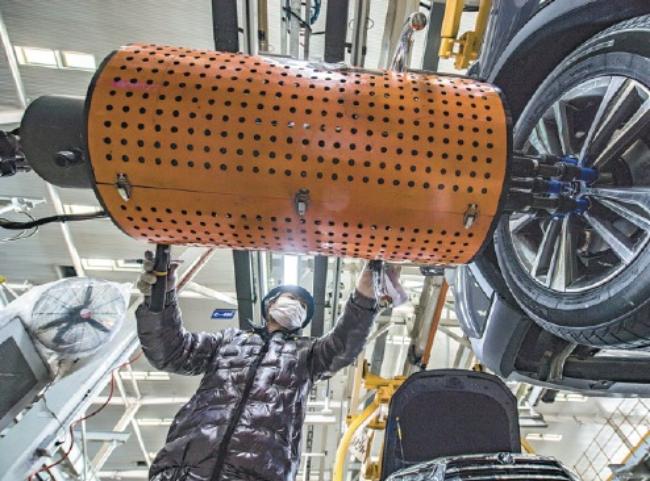 In this undated file photo, an employee works on the production line of an automaker in Xi'an, capital of Northwest China's Shaanxi province. (YUAN JINGZHI / FOR CHINA DAILY)
In this undated file photo, an employee works on the production line of an automaker in Xi'an, capital of Northwest China's Shaanxi province. (YUAN JINGZHI / FOR CHINA DAILY)
The modest contraction seen in factory activity in February is purely a cyclical phenomenon and economic recovery momentum is still robust in China, experts said on Monday.
The Caixin headline Purchasing Manager's Index (PMI) came in at 50.9 last month, slightly down from the 51.5 seen in January, but still in positive territory.
Manufacturing output slowed last month to a 10-month low due to weak overseas demand and coronavirus flare-ups in some countries. Exports contracted for a second month in a row.
Despite the headwinds, manufacturers remained more optimistic about the business outlook for the next 12 months. The degree of positivity was the second-highest in six-and-a-half years
Erin Xin, an economist with HSBC, said the lull was largely due to the Chinese Lunar New Year holiday and tighter restrictions due to some domestic COVID-19 clusters this year.
The slower pace of expansion seen in February is a temporary phenomenon, said Xin. As more people stayed at their places of work during the holidays instead of returning to their hometowns for family reunions, work resumption has been much smoother this year. Therefore, the supply side will continue to see "strong growth on the back of the still resilient domestic demand and a gradual recovery", she said.
Purchasing activities by companies rose slightly in February, according to the Caixin report. Inventories of purchased items dropped for the second consecutive month while stocks of finished goods rose marginally.
ALSO READ: Caixin: China securities monitor looks to work closely with US
Rising prices of raw materials and higher transportation costs in February resulted in higher costs for manufacturers in general. Prices charged by manufacturers rose as companies looked to pass on part of the costs to customers.
Despite the headwinds, manufacturers remained more optimistic about the business outlook for the next 12 months. The degree of positivity was the second-highest in six-and-a-half years.
Wang Zhe, a senior economist at Caixin Insight Group, said the confidence was mainly due to the accumulated experiences in fighting the pandemic over the past year, as well as expectations that the wider COVID-19 flare-ups were coming to an end.
Tang Jianwei, chief researcher at Bank of Communications' financial research center, said in a note that high frequency data such as major steel prices have been rising since mid-February, indicating a rapid resumption of production after the Spring Festival.
As cyclical impacts wrap up, the subindexes of the PMI, including manufacturing, services and construction industry activity, are all expected to pick up in March, further buoying the headline index. Therefore, the temporary slide will not change the trajectory of China's economic recovery, Tang said.
READ MORE: China's manufacturing PMI edges down to 50.6 in February
Confidence in China's economic outlook can also be felt in the stock market. Glass and ceramic manufacturers listed on the A-share market rose by 4.2 percent on Monday, while the benchmark Shanghai Composite Index climbed 1.21 percent to close at 3551.4 points. Fertilizer providers saw their share prices rise by 4.04 percent on average while polyester firms went up by 3.67 percent on Monday.


